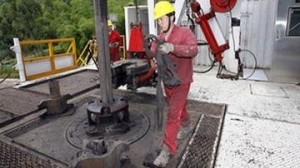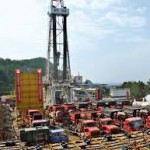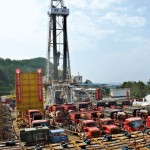 Barely one year ago, China’s government announced ambitious targets for shale gas production of 6.5 billion cubic metres per year by 2015 and 60-100 billion cubic metres by 2020. Now, even the Chairman of Sinopec, Fu Chengyu, is joining the international oil companies and a wide range of commentators in urging a more realistic assessment of the time needed to bring about significant production of shale gas. But China is not alone in experiencing a reality check to over-ambitious rhetoric. This May, two North American oil companies, Marathon and Talisman, announced that they would be selling their shale gas blocks in Poland, joining ExxonMobil which withdrew last year.
Barely one year ago, China’s government announced ambitious targets for shale gas production of 6.5 billion cubic metres per year by 2015 and 60-100 billion cubic metres by 2020. Now, even the Chairman of Sinopec, Fu Chengyu, is joining the international oil companies and a wide range of commentators in urging a more realistic assessment of the time needed to bring about significant production of shale gas. But China is not alone in experiencing a reality check to over-ambitious rhetoric. This May, two North American oil companies, Marathon and Talisman, announced that they would be selling their shale gas blocks in Poland, joining ExxonMobil which withdrew last year.
The US shale gas revolution was driven by an almost perfect combination of favourable geology, an innovative technological and commercial environment, and supportive policies and regulations. The rhetoric only started once success had been demonstrated. In China, as in Poland, the rhetoric began too early. Substantial reserves of shale gas probably do exist in China, but much work needs to be done to assess and extract the gas in large quantities and the government’s actions fall short of what is required to meet its ambitious targets.
The technological challenges are likely to be greater than in the USA, for most of the prospective shales in China lie at greater depth and are less easy to fracture, being less brittle. These geological obstacles are compounded by the shortage of water across much of northern China and the increasing frequency and severity of droughts in southern China. These factors will significantly raise the cost of production.
Despite these potential difficulties, a number of international oil companies have signed joint study agreements with Chinese national oil companies, including BP, Chevron, ConocoPhillips, Total, ExxonMobil and Eni. In March, approval was given for Shell to enter a production sharing contract with PetroChina. Despite these displays of interest, it is the inadequacy of policy and regulatory framework which will act as the real constraint on progress.
The most important source of these constraints is to be found in the political economy of China’s oil and gas industry. PetroChina and Sinopec, and their predecessor ministries, have dominated the nation’s onshore upstream oil industry for decades. Not only do they produce most of the crude oil, oil products and natural gas, but they also have rights over the most prospective areas for shale gas. In an effort to reduce the grip of these companies on shale gas resources, the government held a licensing round for shale gas in 2012 over areas outside those held by PetroChina and Sinopec. But in its efforts to protect domestic interests, the government permitted only Chinese companies to bid. With the national oil companies excluded, it is not surprising that none of the winners of the eighteen blocks announced in January 2013 has any experience in oil and gas exploration. Together they have three years to drill 30-40 wells in what are seen as relatively unprospective areas, many of which have tough topography. It is most unlikely that these drilling commitments will be met, let alone significant gas production achieved.
The outlook for shale gas production in areas occupied by PetroChina and Sinopec should be better, as these companies hold the best areas and have experience in conventional oil and gas production. Both PetroChina (with Shell) and Sinopec have announced early production of shale gas from the Sichuan Basin, but this may not foreshadow a rapid surge in output, for a number of reasons.
First, it not clear that these national oil companies, with or without international partners, will have the innovative capacity and commercial incentive to replicate the US experience. The industrial environment is insufficiently supportive of the technological innovation needed to adapt the US experience to China’s geological conditions. The US shale gas revolution was driven by small, entrepreneurial production and service companies, quite unlike China’s national oil companies and their large international partners. Further, both PetroChina and, to a lesser extent, Sinopec, have many other project opportunities to pursue, not least in the production of conventional gas resources, and the current pricing system for gas is unlikely to provide sufficient financial returns to any investor, despite the additional subsidies on offer.
Second, the policy environment for foreign investors is quite uncertain. Although they have been allowed to sign joint study agreements with the national oil companies, they were prohibited from participating in the license rounds. The government took almost one year to give approval to Shell’s production sharing contract with PetroChina, and has not clarified whether or not this contract forms a precedent for future arrangements with foreign companies. This ambiguity is exacerbated by the general lack of suitability of conventional production sharing contracts to the exploitation of unconventional resources such as shale gas and coal-bed methane. The operating and business processes are quite different, for unconventional resources require a much larger number of wells to be drilled as well as greater flexibility in operating plans.
All companies seeking to produce shale gas in China will need to manage two further challenges. First, they will need to work closely with local communities to gain access in a fair and legal manner to the land required for drilling. Second, they will have to take the greatest care in the use and disposal of water injected for hydro-fracturing, an issue on which the government has yet to produce detailed regulations.
Foreign investors should also take note of Chevron’s experience in trying to start production at the Chuandongbei gas field in Sichuan province. Chevron and PetroChina signed a production sharing contract for the development of this proven gas field in 2007. But disagreements over risk management and the development plan have delayed first production by four years; and this was a conventional gas field, albeit with hazardous levels of hydrogen sulphide that killed many local people after a blow-out in 2003 when the field was operated by PetroChina.




